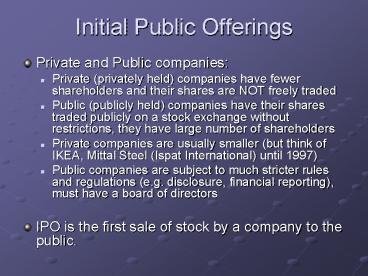Initial Public Offerings - PowerPoint PPT Presentation
1 / 10
Title:
Initial Public Offerings
Description:
Private companies are usually smaller (but think of IKEA, Mittal Steel (Ispat ... than investors signaling by underpricing as a response to the lemons problem ... – PowerPoint PPT presentation
Number of Views:54
Avg rating:3.0/5.0
Title: Initial Public Offerings
1
Initial Public Offerings
- Private and Public companies
- Private (privately held) companies have fewer
shareholders and their shares are NOT freely
traded - Public (publicly held) companies have their
shares traded publicly on a stock exchange
without restrictions, they have large number of
shareholders - Private companies are usually smaller (but think
of IKEA, Mittal Steel (Ispat International) until
1997) - Public companies are subject to much stricter
rules and regulations (e.g. disclosure, financial
reporting), must have a board of directors - IPO is the first sale of stock by a company to
the public.
2
A bit on the mechanics of IPO
- 3 players
- Issuer
- Investment Bank (Underwriter)
- Investors
- Issuer supply audited financial statements and
prepare a prospectus (details of the company) - Investment Bank conducts a due diligence
investigation and helps to price and place the
offer - Road Show presentation of securities to
potential buyers (mainly institutional investors)
3
Reasons for Going Public(see Röell (1996))
- New Finance
- Direct. Funds raised at IPO
- Indirect. Helps to raise funds in the future
- Reduction in leverage (mitigates debt overhang
and other problems of debt). But why not private
placement? ?? - Increase in liquidity of stock and
diversification. - Liquidity is valuable per se, but in addition it
helps to raise funds in the future (more precise
information about a firms value helps to attract
finance) - Increased competition among suppliers of finance
4
Reasons for Going Public (cont-d)
- Greater dispersion of ownership mitigates the
problem of overmonitoring of managers by
shareholders (will be discussed in detail at the
end) - Enhanced company image and publicity
- Visibility of the company and its products
- Motivating management and employees
- E.g. through conditioning compensation on the
stock price (stock-based compensation) - Cashing in
- Exploiting mispricing
- Timing issues to take advantage of swings in
investor sentiment - Other benefits (unexpected side effects)
- Closer working relationships with professional
advisers (esp. brokers) - Formulation of a clearly defined strategy for
growth - Improved management and organizational and
financial structure
5
Costs of Going Public
- Direct costs (underwriting, auditing and legal
fees, effort) - Cost of information disclosure
- Underpricing
- Cost of constraining business decisions
- Tax implications
- Greater transparency of accounts may lead to more
taxes paid - Danger of loss of control
6
Underpricing at IPO
- Widely documented phenomenon offering price is
typically lower than the market price of the
shares right after the IPO - Ritter and Welch (2002), US data (but the same
seems to be true for other countries too) - In the sample of 6,249 IPOs from 1980 to 2001 the
average first-day return is 18.8 percent. - About 70 percent of the IPOs end the first day of
trading at a closing price greater than the offer
price and about 16 percent have a first-day
return of zero.
7
Some Theories of Underpricing
- Theories based on asymmetric information
- Issuer is better informed than investors
signaling by underpricing as a response to the
lemons problem - Good firms separate themselves from bad ones by
offering underpriced stock - Some investors are more informed than others and
the issuer (e.g. about market demand for shares) - Winners curse uninformed investors are afraid
to buy unless the price is sufficiently low. If
they buy, but informed investors dont, that
means that they lose money and they do not share
the losses with informed investors, because
informed investors DONT buy exactly when the
issue is overpriced.At the same time, the gains
in case the issue is underpriced are shared with
informed investors
8
Some Theories of Underpricing (cont-d)
- Underwriter is more informed than the issuer
- To exert better effort, he needs to be
compensated for using his superior information by
allowing to offer the issue at easier conditions,
i.e. at lower price. - Informational cascades
- An investor is looking at whether other investors
are buying the shares. If there are sufficiently
many others buying, he concludes that the stock
is worth buying. If the initial price is too
high, the firm risks that nobody will start
buying the shares, hence no cascade will start - Some other theories
- Avoiding legal liabilities (more relevant for the
US). - Drops in prices may trigger lawsuits. So its
better to have a lower price from the start. - Achieving greater liquidity through greater
ownership dispersion
9
Decision to Go Public
- The decision to go public should be based on the
comparison of the mentioned benefits and costs
(direct and indirect) of doing an IPO - Many models focusing on specific costs and
benefits. - In Corporate Finance II we will discuss Zingales
(1995). In the presence of a prospective
acquirer, going public first maximizes aggregate
proceeds from selling a company. - Today we will discuss Pagano and Röell (1998)
10
Key References
- Ritter (1998), Initial Public Offerings,
bear.cba.ufl.edu/ritter/rittipo1.pdf - Röell (1996), The Decision to Go Public An
Overview, European Economic Review 40, pp.
1071-1081 - Ritter and Welch (2002), A Review of IPO
Activity, Pricing, and Allocations, Journal of
Finance, August 2002, pp. 1795-1828 - Pagano and Röell (1998), The Choice of Stock
Ownership Structure Agency Costs, Monitoring,
and The Decision to Go Public, The Quarterly
Journal of Economics, February 1998, pp. 187-225.















![❤[PDF]⚡ New Deal Ruins: Race, Economic Justice, and Public Housing Policy PowerPoint PPT Presentation](https://s3.amazonaws.com/images.powershow.com/10047352.th0.jpg?_=20240604104)















